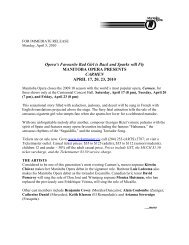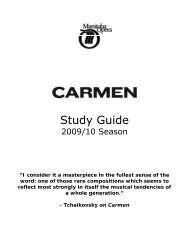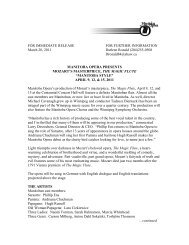La Traviata Study Guide - Manitoba Opera
La Traviata Study Guide - Manitoba Opera
La Traviata Study Guide - Manitoba Opera
Create successful ePaper yourself
Turn your PDF publications into a flip-book with our unique Google optimized e-Paper software.
THE REAL VIOLETTA AND ALFREDO<br />
Violetta Valery and Alfredo Germont were, in reality, the beautiful Parisienne prostitute, Marie<br />
Duplessis and Alexandre Dumas fils, son of the famous novelist Alexandre Dumas (author of<br />
The Three Musketeers and many similar books). Marie and Alexandre first met at the opera in<br />
1844 when both were 20 years old; they were lovers for 11 months. A year after Marie died in<br />
1847, Dumas fils published a novel describing their affair, <strong>La</strong> dame aux Camélias. (The<br />
misspelling of the word, Caméllias, was inherited from a George Sands’ 1846 novel Isidora.)<br />
In the book, Dumas fils explained the origin of Marie’s nickname, “The lady of the camellias” in<br />
a passage discussing her penchant for the theatre:<br />
Marguerite was present at all first nights and spent each evening in the<br />
theatre or at a ball….she always had with her a bunch of camellias. For<br />
twenty-five days in every month the camellias were white, and for five<br />
they were red. No one ever knew the reason for this variation in color which<br />
I mention but cannot explain.<br />
The author’s “inability” to explain is, of course, an example of nineteenth century delicacy.<br />
In the opera, Violetta is persuaded to end the affair because it threatens the marriage of Alfredo’s<br />
sister. In real life, this never happened; the lover separated for another reason. During the first<br />
several months of their affair in 1844, Marie had continued to work as a prostitute. This made<br />
her lover insanely jealous, but, business was business. However, in 1845, the two rented a<br />
summer home in the Paris suburb of Bougival and Marie abandoned her profession. Then after<br />
four months, the lovers ran out of money and they split up so that Marie could return to her old<br />
work (one of her new lovers was Franz Liszt). However, tuberculosis was to kill her a year and a<br />
half later in 1847 at the age of just 23. There was no final reunion with Alexandre as described in<br />
both the play and opera; Alexandre was travelling abroad.<br />
Marie was born in Normandy as Alphonsine Plessis. Her mother died when she was young and<br />
her brutal father put her to work as a prostitute at age 12. At age 16, after having escaped to<br />
Paris, she began working the streets as a grisette (a working girl who augmented her income was<br />
called this because they work grey clothes). Her beauty enabled her to soon advance to the demimonde<br />
(salons instead of the streets and a world that fell between polite society and the<br />
underworld) and it was then that she changed her name to the “more elegant” Marie Duplessis.<br />
Alexandre Dumas fils was a respected member of the French literary establishment, but none of<br />
his other works ever achieved the lasting fame of <strong>La</strong> dame aux Camélias. He took several<br />
mistresses after Marie, and was married twice. He was made a Chevalier de la Légion d’honneur<br />
in 1857 and in 1875 was elected to the French Academy before dying in 1895.<br />
11








